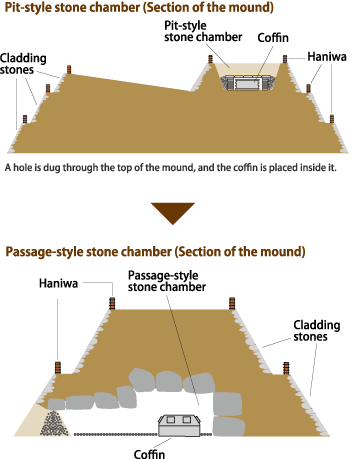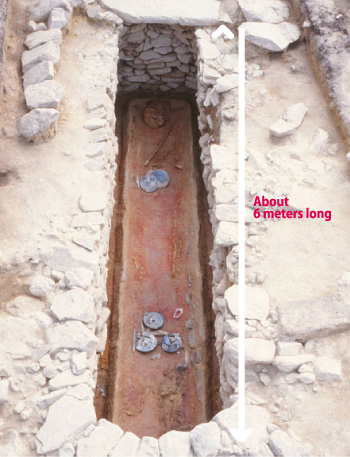- English TOP>
- Mozu-Furu Q&A>
- Mozu-Furu Q&A Vol.06

- When you see kofun close up, you might be surprised at how big they are. And because they are covered with trees, they look more like forests.
But what is the inside of a kofun like?
A kofun is a kind of grave, with a body laid out in a chamber buried inside a mound of piled earth.
In round or square kofun, the body was buried in the center of the mound. In keyhole-shaped kofun, the burial was usually in the round rear portion.
In the burial location, stones would be piled up to form the walls of a chamber and the top would be sealed with large stones, creating what is known as a "stone chamber".
The style of the stone chamber changed as time went on. From the beginning to about the middle of the Kofun Period, the trend was for "pit-style" stone chambers, but later this changed to the "passage-style". When the Mozu-Furuichi Kofungun tumuli were built, the pit-style stone chamber was the major stream.
- Kofun Period Fashions
-
 An entrance is made in the side of the mound, the stone chamber widens toward the center, and the coffin is placed there.
An entrance is made in the side of the mound, the stone chamber widens toward the center, and the coffin is placed there.

- The main difference is that the entrance is either at the top or the side of the mound, but there are others.
In a pit-style stone chamber, the coffin was first placed in the chamber, after which the roof of the chamber was sealed with large stones and the top was decorated with haniwa, etc.
This meant that the chamber could not be re-opened once it was sealed, and was basically made for one person.
On the other hand, the passage-style stone chamber could be entered repeatedly by removing the stones and earth blocking the entrance, even after the coffin had been buried. As a result, many of these were used over long spans of time. In fact, the same tomb appears to have been used to bury two or three generations in some cases.
In the days of the Mozu-Furuichi Kofungun, blood relatives often seem to have been buried together.
Research on excavated bones shows that wives were buried in the tombs of their parental families. This makes us think that husbands and wives were not kept together after death.
Although kofun are "graves", there is clearly a big difference in what they signified then, compared to now.
 Pit-style stone chamber (Yukinoyama Kofun), image provided by Higashi-Omi City Board of Education
Pit-style stone chamber (Yukinoyama Kofun), image provided by Higashi-Omi City Board of Education*Reproduction not permitted










